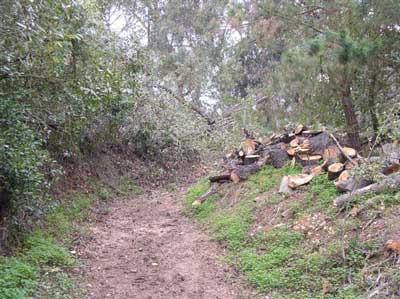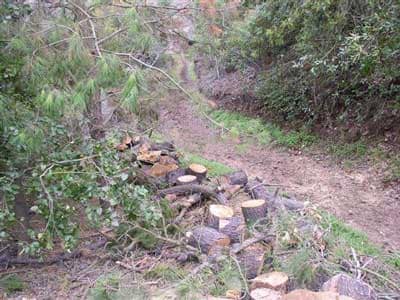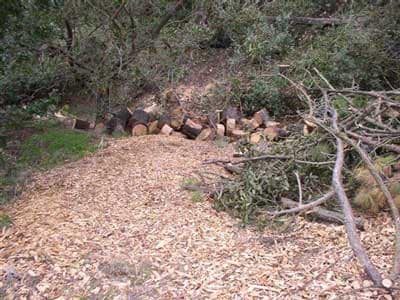A Tree Trimmer Dies When He Falls from a Tree and is Struck by a Limb
California Case Report: 09CA010
Summary
A 43-year-old tree trimmer died after being struck by a limb of an adjacent tree. The victim was cutting off branches as he climbed up a dead tree. He had climbed to about 30 feet and cut off the top of the tree. As the treetop fell it struck an adjacent tree, which then toppled and caused the tree in which the victim was working to fall. As he fell towards the ground with his fall arrest equipment anchored to the tree, the victim was struck in the face by the branch of a third tree. Co-workers freed the victim from the fallen tree and called for assistance. When emergency responders finally arrived on the scene the victim was pronounced dead. The CA/FACE investigator determined that in order to prevent future incidents, employers who employ tree trimmers should ensure that:
- Every tree removal job is assessed for potential hazards posed by dead trees, and safe work procedures to eliminate the hazards are implemented.
- Tree trimming and felling should be performed or supervised by workers trained and certified by organizations such as the ISA (International Society of Arboriculture).
Introduction
On Friday December 18, 2009, at approximately 10:30 a.m., a 43-year-old Hispanic tree trimmer died after the tree in which he was working was toppled by an adjacent tree. The CA/FACE investigator received notification of this incident on December 21, 2009, from the Torrance District Office of the Division of Occupational Safety and Health (Cal/OSHA). On December 21, 2009, the CA/FACE investigator inspected the incident site and interviewed the owner of the landscape company who employed the victim. On January 5, 2010, interviews were conducted with six employees of the company.
The victim was born in Mexico and had been in the Los Angeles area for 26 years. It is not known how long the victim had been in the United States. The victim had a sixth grade education. According to the owner of the company, the victim spoke both English and Spanish. The victim’s supervisor was also bilingual and spoke Spanish to the employees on the job. The victim had been employed with the company for three years as a tree trimmer. According to the victim’s employment application, he had over 20 years experience working as a tree trimmer, but was not certified as a tree trimmer by the ISA.
The employer of the victim was a landscaping company that had been in business for 27 years and had 95 employees. There were five employees on site at the time the incident occurred. The employer had a written Injury and Illness Prevention Program (IIPP). There were weekly documented safety training meetings where various safety topic materials were distributed in Spanish and discussed. Most of the topics were related to landscaping procedures and general safety practices. They did not cover dead tree identification, climbing, trimming or removal. Training records indicated the victim received classroom training in tree trimming and safety in August of 2008.
Investigation
The victim was part of a five person crew assigned to remove dead and fallen Monterey Pine and Eucalyptus trees from a heavily wooded hiking and horse trail on a remote steep hillside behind exclusive residential estates. According to the owner of the company, he had given the crew the address of the remote location where the dead and fallen trees were located and told them he would meet them at the site. Once there, the company owner showed the crew the brush and trees that needed to be removed and left to conduct other business.
The crew proceeded to cut and remove the brush and dead trees. The victim connected his fall arrest equipment, lanyard and harness, onto a dead Monterey Pine tree and began trimming off the branches with a chainsaw as he climbed the tree. He had climbed to about 30 feet and cut off the top of the tree. As the treetop fell it struck an adjacent tree, which then toppled and caused the tree in which the victim was working to fall. As he fell towards the ground with the tree, the victim was struck in the face by the branch of a third tree. Co-workers cut the victim out of his harness and lowered him to the ground. Emergency response could not be contacted immediately because of the remote working area. The fire department and paramedics arrived approximately 25 minutes after the incident occurred and pronounced the victim dead at the scene.
Cause of Death
The cause of death, according to the death certificate, was blunt head injury.
Recommendations/Discussion
Employers who employ tree trimmers should ensure that:
Recommendation #1: Every tree removal job is assessed for potential hazards posed by dead trees, and safe work procedures to eliminate the hazards are implemented.
Discussion: The owner of the company had assessed the worksite earlier to determine the extent of work, equipment needed, and the number of employees to do the job. However, no specific instructions were given to the victim about the safe methods to fell the dead trees. In this area, there was enough room to safely fell the trees without climbing to top or trim them. Where dead trees are located in areas where it is not safe to simply fell, further assessment needs to be done to determine if the tree can be climbed. Such assessment should include:
- Surrounding areas including other trees and the trees to be removed.
- Species and shape of the trees to be removed.
- The lean of the trees.
- Loose limbs, chunks, or other overhead material.
- Wind forces and direction.
- Dead, decayed, or weak spots throughout the trees.
- Size and terrain characteristics and limitations of the work area.
- Evidence of bees or wildlife habitation in the trees.
- Means to protect all employees and property.
In this case, if the dead tree has been simply felled, the victim would not have climbed the tree and been struck by a branch as he fell.
Recommendation #2: Tree trimming and felling should be performed or supervised by workers trained and certified by organizations such as the ISA (International Society of Arboriculture).
Discussion: In this incident, the victim had over 20 years of experience in tree trimming and may have been familiar with general safety procedures. However, it is not clear if this experience included knowledge of the best methods for removing dead trees, or if the victim’s skills had been rigorously assessed through job supervision and testing. The victim may have assumed that the tree he was climbing was stable. The ISA is one organization that certifies tree trimmers in all aspects of job safety, including the best methods for felling dead trees. All ISA-certified tree workers must pass a knowledge and skills exam conducted by trained evaluators. The victim had received training in tree trimming and safety in 2008, but it was not a certified course sanctioned by ISA or a similar organization. If the victim had received certification or was supervised by someone who was certified, he or the supervisor may have had the knowledge to recognize the hazards in the work area. If the victim had decided to simply fell the tree, or to bring in a bucket truck to trim and top before felling, he would not have climbed the tree thereby preventing his death.
Reference
- Division of Occupational Safety and Health – Title 8 regulations – Subchapter 7 – General Industry Safety Orders Group 3. Tree Work, Maintenance or Removal §3421. General. §3427. Safe Work Procedures. §3428. Operating Rules.
- NIOSH Alert: Preventing Falls and Electrocutions During Tree Trimming https://www.cdc.gov/niosh/docs/92-106/ (Link Updated 3/20/2013)
- New Jersey FACE Investigations:
Tree Trimmer Killed When a Branch to Which He Was Tied Broke And His Lifeline Failed https://www.cdc.gov/niosh/face/stateface/nj/96nj074.html
Tree Trimmer Dies After Falling With a Fractured Tree
https://www.cdc.gov/niosh/face/stateface/nj/95nj016.html - Tree Care Industry Association Safety Materials: external iconhttp://tcia.org/publications (Link Updated 8/13/2013)
- Z133.1Safety Standard,2006: Safety Standards for Chain- Saw Use, Climbing, Pruning,Rigging, and Removal
Exhibits

|
 |
 |
|
Exhibit 3. The steep hillside adjacent to the trail.
|
California Fatality Assessment and Control Evaluation (FACE) Project
The California Department of Public Health, in cooperation with the Public Health Institute and the National Institute for Occupational Safety and Health (NIOSH), conducts investigations of work-related fatalities. The goal of the CA/FACE program is to prevent fatal work injuries. CA/FACE aims to achieve this goal by studying the work environment, the worker, the task the worker was performing, the tools the worker was using, the energy exchange resulting in fatal injury, and the role of management in controlling how these factors interact. NIOSH-funded, State-based FACE programs include: California, Iowa, Kentucky, Massachusetts, Michigan, New Jersey, New York, Oregon, and Washington.
To contact California State FACE program personnel regarding State-based FACE reports, please use information listed on the Contact Sheet on the NIOSH FACE web site. Please contact In-house FACE program personnel regarding In-house FACE reports and to gain assistance when State-FACE program personnel cannot be reached.
